Today Current Affairs: 25rd September 2021 for UPSC IAS exams, State PSC exams, SSC CGL, State SSC, RRB, Railways, Banking Exam & IBPS, etc
Table of Contents
Solar DC Cooking System:
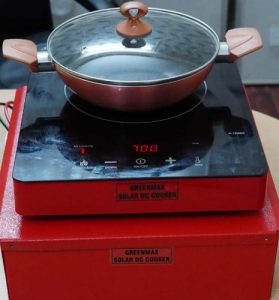
The solar DC cooking technology was developed by the Central Mechanical Engineering Research Institute (CMERI).
- The CMERI is an institute under the Council for Scientific and Industrial Research (CSIR).
- It is a Solar Energy based Cooking System which consists of a solar PV panel, charge controller, battery bank and cooking oven.
- It provides a Clean Cooking Environment, Invertor-Less Direct Operation, Fast and Uniform Heating and a potential to save 1 ton Carbon Dioxide emissions per year/household.
- It has 20-25% better efficiency and is more Economical in comparison with Conventional Solar based Cooking Systems which loses efficiency owing to AC-DC conversion.
- The simple Technology Design also ensures Ease-of-Manufacturing and thus provides a substantial Economic Opportunity for the Micro-Industries.
- It will cost in the range of Rs 65,000- Rs 70,000 and if Government subsidies are provided there will be a significant reduction in the price of the product.
- Widespread usage the system can also play a critical role in achieving the target of 200 GW of Solar energy and also to save almost 290 million tons of Carbon Dioxide emissions.
- Along with the widening of the popularity base of Technology, there is a probability of improvement in Job Prospects.
Defence Corridors:
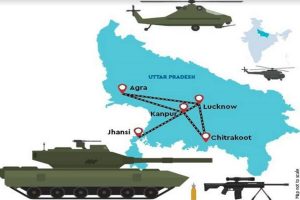
The Prime Minister visited the exhibition models of the Aligarh node of the upcoming Uttar Pradesh Defence Industrial Corridor.
- It was announced by the Prime Minister while inaugurating the UP Investors Summit in Lucknow in 2018.
- The government has established another Defence Industrial Corridor in Tamil Nadu.
Defence Industrial Corridor of UP:
- It is an aspirational project that intends to reduce foreign dependency of the Indian Aerospace & Defence Sector.
- It will have 6 nodes – Aligarh, Agra, Kanpur, Chitrakoot, Jhansi and Lucknow.
- The Uttar Pradesh Expressways Industrial Development Authority (UPEIDA) is the nodal agency to execute this project in conjunction with various other state agencies.
- It aims to bring up the state as one of the largest & advanced Defence manufacturing hubs and put it on the world map.
Features:
- Single Window approvals and clearances to Defence and Aerospace (D&A) manufacturing units via Nivesh Mitra.
- Nivesh Mitra Portal has been launched by the Government of Uttar Pradesh to ease the Ease of Doing Business in the state.
- Labour Permits for D&A industry towards flexible employment conditions.
- Simple Procedures and rationalised regulatory regime with easy reimbursement of incentives and subsidies.
- Assured water supply and uninterrupted electricity.
- Connectivity with 4-lane heavy-duty highway.
About Defence Corridors:
- A defence corridor refers to a route or a path along which domestic productions of defence equipment by public sector, private sector and MSMEs are lined up to enhance the operational capability of the defence forces.
- It will help in making the nation self-reliant in the field of defense production and promoting ‘Make in India’, which will reduce our imports and promote the export of these items to other countries.
- It will provide a fillip to the defence manufacturing ecosystem through synergistic development of technologies, promote the growth of private domestic manufacturers, including MSMEs and Start-Ups.
What Are Stablecoins?

The US is discussing launching a formal review into whether Tether and other stablecoins threaten financial stability.
- The first stablecoin, created in 2014, was Tether.
- A stablecoin is a type of cryptocurrency that is typically pegged to an existing government-backed currency.
- A cryptocurrency is a form of digital asset based on a network that is distributed across a large number of computers.
- Stablecoins hold a bundle of assets in reserve, usually short-term securities such as cash, government debt or commercial paper.
- Stablecoins are useful because they allow people to transact more seamlessly in cryptocurrencies that function as investments, such as Bitcoin.
- They form a bridge between old-world money and new-world crypto aslo they promise to function like perfectly safe holdings.
Types:
Fiat-collateralized Stablecoins:
- They are collateralized by fiat money, such as the US dollar, euro or the pound, on a 1:1 ratio.
- Examples: Tether, Gemini Dollar, and TrueSD.
Stablecoins Backed by Other Assets:
- There are a few stablecoins, which are backed by a basket of multiple assets (commercial papers, bonds, real estate, precious metals, etc).
- The value of these stablecoins can fluctuate over time subject to movement in commodity and precious metal prices.
- Example: Digix Gold, backed by physical gold.
Crypto-Collateralized Stablecoins:
- Crypto-collateralized stablecoins are more decentralised than their peers and are backed by cryptocurrencies.
- The flipside is price volatility and to address the risk of price volatility, these stablecoins are over-collateralized.
- Example: Dai.
Non-collateralized stablecoins:
- These stablecoins do not have any backing and are decentralized in the true sense and the supply of non-collateralized stablecoins is governed by algorithms.
- Example: Basis.
Capacity Of India’s Sewage Treatment Plants:

According to the latest report of the Central Pollution Control Board (CPCB), Sewage Treatment Plants (STPs) in India are able to treat a little more than a third of the sewage generated per day.
- CPCB is a statutory organisation which was constituted in September, 1974 under the Water (Prevention and Control of Pollution) Act, 1974.
Highlights of the Report:
- India generated 72,368 MLD (million litres per day) whereas the installed capacity of STPs was 31,841 MLD (43.9%).
- 5 states and Union Territories (UT) – Maharashtra, Gujarat, Uttar Pradesh, Delhi and Karnataka – account for 60% of the total installed treatment capacity of the country.
- Arunachal Pradesh, Andaman & Nicobar Islands, Lakshadweep, Manipur, Meghalaya and Nagaland have not installed sewage treatment plants.
- Chandigarh ranks first in terms of total sewage generated to what is actually treated.
- Reuse of Treated Sewage:
- It is maximum in Haryana followed by Puducherry, Delhi, Chandigarh.
- It has not assumed much importance in the policy planning of many state governments.
- Treated sewage water can be reused for horticulture, irrigation, washing activities (road, vehicles and trains), fire-fighting, industrial cooling, toilet flushing and gardening.
- This can decrease the water demand from aquatic sources like rivers, ponds, lakes and as well as groundwater
NASA’s VIPER Mission:
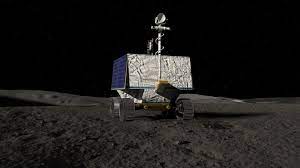
NASA has chosen a landing site for the Volatiles Investigating Polar Exploration Rover (VIPER).
- The site is on the western edge of Nobile crater, near the lunar south pole. The crater was named after Italian polar explorer Umberto Nobile.
- NASA, in July 2021, announced that it will launch its Volatiles Investigating Polar Exploration Rover, or VIPER, in 2023.
- NASA is undertaking the mission to understand if it is possible for human life to sustain there, by using locally available resources.
About the mission:
- VIPER is a mobile robot.
- It is the first resource mapping mission on any other celestial body.
- NASA’s Commercial Lunar Payload Services (CLPS) will be providing the launch vehicle and lander for what’s going to be a 100-day mission.
Objectives of the mission:
- To explore the Moon’s South Pole region.
- Help create lunar resource maps.
- Evaluate the concentration of water as well as other potential resources on its surface.
Significance of the mission:
- VIPER’s findings will inform “future landing sites under the Artemis program by helping to determine locations where water and other resources can be harvested” to sustain humans over extended stays.
Black Carbon Emissions:

With Arctic summer ice reaching its 12th lowest ever extent, the Clean Arctic Alliance has called for urgent cuts to black carbon emissions from shipping, ahead of the 77th Marine Environment Protection Committee (MEPC) meeting (MEPC 77) at the International Maritime Organization (IMO) in November.
About the Marine Environment Protection Committee (MEPC):
- In order to ensure that a proactive stance is taken by in order to protect and safeguard the interests of the marine environment and ecosystem, the IMO has established the Marine Environment Protection Committee (MEPC).
- The committee seeks to provide a solution for the problem of air pollution caused by the constant and heavy traffic of ships in the oceanic areas.
- The committee in its sessions also seeks to provide required revisions to the existing MARPOL stipulations and guidelines.
- The creation and enforcement of PSSAs (Particularly Sensitive Sea Areas) and other special oceanic zones is also an area that is looked into by the environment protection organisation.
Black carbon results from the incomplete combustion of fossil fuels and biomass. BC is produced both naturally and by human activities as a result of the incomplete combustion of fossil fuels, biofuels, and biomass.
- Primary sources include emissions from diesel engines, cook stoves, wood burning and forest fires.
- It is a short-lived pollutant that is the second-largest contributor to warming the planet behind carbon dioxide (CO2
6th Edition Of Exercise SCO Peaceful Mission 2021:
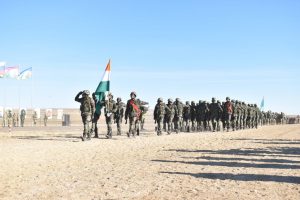
Indian Military Contingent recently participated in the 6th Edition of Exercise SCO Peaceful Mission 2021 at Orenburg, Russia.
Exercise SCO Peaceful Mission:
- Joint Counter Terrorism Exercise PEACEFUL MISSION is a Multilateral Exercise, which is conducted biennially as part of military diplomacy between Shanghai Cooperation Organisation (SCO) member states.
- The aim of the exercise is to foster close relations between SCO member states and to enhance abilities of the military leaders to command multi-national military contingents.
- The exercise will enable sharing of best practices between the Armed Forces of SCO nations.
About the Shanghai Cooperation Organisation (SCO):
- It is a permanent intergovernmental international organisation.
- It’s creation was announced on 15 June 2001 in Shanghai (China) by the Republic of Kazakhstan, the People’s Republic of China, the Kyrgyz Republic, the Russian Federation, the Republic of Tajikistan, and the Republic of Uzbekistan.
- It was preceded by the Shanghai Five mechanism.
State Food Safety Index (SFSI):

The Union Minister for Health and Family Welfare released the 3rd State Food Safety Index (SFSI).
Highlights of the index:
- Among the larger states, Gujarat was the top ranking state, followed by Kerala and Tamil Nadu.
- Among the smaller states, Goa stood first followed by Meghalaya and Manipur.
- Among UTs, Jammu & Kashmir, Andaman & Nicobar Islands and New Delhi secured top ranks.
About the Index:
- The Index is a dynamic quantitative and qualitative benchmarking model that provides an objective framework for evaluating food safety across all States/UTs.
- The first State Food Safety Index for the year 2018-19 was announced on the first-ever World Food Safety Day on 7th June 2019.
- The index is developed by FSSAI (Food Safety and Standards Authority of India) to measure the performance of states on five significant parameters of Food Safety.
- The parameters include Human Resources and Institutional Data, Compliance, Food Testing – Infrastructure and Surveillance, Training & Capacity Building and Consumer Empowerment.
Centre Of Excellence In Logistics And Supply Chain Management:

Union Minister for Commerce & Industry inaugurated the ‘Centre of Excellence in Logistics and Supply Chain Management’ at the National Institute of Industrial Engineering (NITIE), Mumbai.
- Managing supply chains is becoming more and more complex owing to the challenges posed by global competitiveness and economic crisis.
- In this scenario, the Centre will contribute to cutting edge research, knowledge-building and capacity building in Logistics and Supply Chain Management, through applied research and development activities.
- The Centre will act as a driving force to train and launch top quality programs to disseminate advanced knowledge and promote Digitisation, Analytics, and IoT Application and Decision Support Systems through Artificial Intelligence and Machine Learning applications.
- The Centre will carry out research projects to find innovative solutions in collaboration with industry and national and international bodies.
- The focus will be on Logistics and Supply Chain Management along with sustainability and green supply chains.
Air Gun Surrender Campaign:
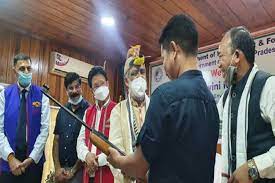
Appealing people to not hunt animals and birds, Union Minister for Environment said that air gun surrender campaign will be launched across the country and retired forest workers, representatives of social organizations etc. will be roped in for the same.
- He described the Air Gun Surrender Campaign of the Arunachal Government as an important initiative to save animals and birds from poaching and for their conservation
- It is giving very positive results said that it will be started across the country and States will also be requested for this.
- Air guns do not require any license. In such a situation, many people in our country hunt birds through air guns in every district and village. Due to this, the number of many birds is rapidly decreasing.
- Union Minister for Environment also visited Itanagar Biological Park, the world’s first Hoolok Gibbon Breeding Canter and reviewed the work being done to save this species.
Holistic Rejuvenation Of Ganga River And Its Basin:

The Union Minister for Jal Shakti chaired a meeting of the Empowered Task Force including several central ministries, departments and the state governments for ensuring better coordination and convergence among agencies and programs for holistic rejuvenation of Ganga River and its basin.
- Among Central Ministries, the Ministry of Agriculture and Farmers Welfare informed that total area under organic farming and agro-forestry increased from 23,840 Ha to 1,03,780 Ha.
- Out of this, land for Organic Farming in Uttarakhand is 50,840 Ha, Uttar Pradesh is 42,180 Ha, Bihar is 16,060 Ha & Jharkhand is 4,540 Ha. along the Ganga.
- The Ministry of Tourism informed that the Ganga Museum in Haridwar is now operational while the one in Rishikesh is ready for inauguration and another Museum in Patna has been sanctioned.
- The Ministry is also working on developing tourists circuits along the Ganga in Uttar Pradesh, Uttrakhand and Bihar.
- Uttarakhand has started 20 big and 410 small outlets to promote organic products along Char Dham yatra while Jharkhand government has started ‘Organic farming authority of Jharkhand’ to promote organic farming in the state especially along the Ganga.
Arjun Mk-1A Main Battle Tanks (MBT):
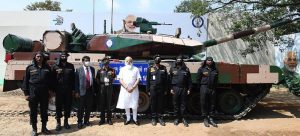
The Defence Ministry placed an order with the Heavy Vehicles Factory (HVF), Avadi, for the supply of 118 indigenous Arjun Mk-1A main battle tanks (MBT) for the Army at a cost of ₹7,523 crore.
- The state-of-the-art MBT Mk-1A is a new variant of Arjun tank designed to enhance fire power, mobility and survivability. Infused with 72 new features and more indigenous content from the Mk-1 variant, the tank would ensure effortless mobility in all terrains, besides precise target engagement during day and night.
- The MBT Arjun Mk-1A was designed and developed by the Combat Vehicles Research and Development Establishment (CVRDE), along with the other laboratories of the Defence Research and Development Organisation (DRDO).
- In February, Prime Minister Narendra Modi formally handed over Arjun Mk-1A to Army chief General Manoj Naravane in Chennai. The Army has two regiments of Arjun Mk1 tanks in service inducted between 2005 and 2010.
- This production order to Avadi factory opens up a large avenue in defence manufacturing for over 200 Indian vendors including MSMEs, with employment opportunities to around 8,000 people.
- The Arjun Mk-1A has 14 major upgrades over the Mk1 variant, which were formulated and approved in October 2018 and subsequently limited user validation trials were carried out of all the upgrades. The Mk1A will be without missile firing capability and will be incorporated as and when the development is complete.
- An Arjun hub has been set up in Jaisalmer where 248 rotables have been deposited to ensure quick support and maintenance for the fleet.
Gogra:
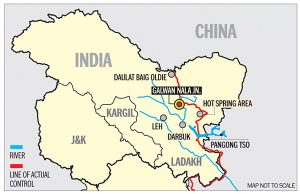
Villagers have lost access to a vast grazing area near Gogra in eastern Ladakh owing to growing Chinese presence in the area.
- Gogra is one of the several friction points in eastern Ladakh where Indian and Chinese troops have been engaged in a stand-off since April-May 2020.
- The troops have disengaged from the north and south banks of the Pangong Tso and Gogra sector, creating “no zones” in areas along the undemarcated Line of Actual Control (LAC) that was regularly patrolled by Indian troops prior to April 2020.
- The Army had stopped the villagers’ access to the Kiu La pass that was till a few years ago frequented by the villagers of Lukung, Phobrang and Yourgo for cattle-grazing.
- Since April 2020, Chinese troops have blocked Indian troops from reaching at least 10 patrolling points (PPs) in eastern Ladakh — running from Depsang plains in the north to the Pangong Tso lake in the south.
National Service Scheme (NSS) Awards For The year 2019-20:
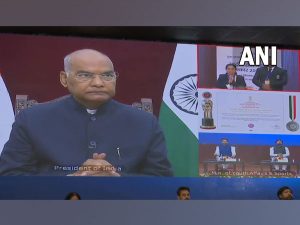
The President of India Shri Ram Nath Kovind will confer the National Service Scheme (NSS) Awards for the year 2019-20 on 24th September, 2021 from Rashtrapati Bhawan, New Delhi.
- The National Service Scheme (NSS) Award for the year 2019-20 will be given to 42 awardees in 3 different categories like University/ +2 Councils, NSS Units and their Programme Officers and NSS Volunteers.
- Ministry of Youth Affairs & Sports confers every year the National Service Scheme Award to recognize and reward outstanding contributions towards voluntary community service made by the Universities/Colleges, (+2) Councils, Senior Secondary, NSS Units/ Programme Officers and NSS Volunteers, with a view to further promote NSS in the country.
- NSS is a Centrally Sector Scheme which was launched in the year 1969 with the primary objective of developing the personality and character of the student youth through voluntary community service.
- The ideological orientation of the NSS is inspired by the ideals of Mahatma Gandhi. Very appropriately, the motto of NSS is “NOT ME, BUT YOU”.
- The NSS volunteers work on issues of social relevance, which keep evolving in response to the needs of the community, through regular and special camping activities.




